
Sirui T-025X Carbon Fibre Tripod Kit
In summary
The Sirui T-025X tripod isn't the cheapest compact tripod on the market but it is definitely the cheapest carbon fibre one.
It's also the lightest compact tripod we were able to find - and the combination of small size, light weight and affordable price tag makes it very attractive.
It's not without a few (albeit relatively minor ) flaws (see the full review), but aside from these, the Sirui T-025X tripod is so easy to carry it's likely to qualify as the 'best' tripod since it's the one you are most likely to have at hand.
Whether it's in your camera bag or attached to it, carried on your belt loop or sitting in a bicycle basket or on a car seat, it's a small burden to carry. And it comes with a six-year warranty for peace of mind.
Full review
Travelling photographers who want the optimum combination of light weight and stability have known for a long time that carbon fibre tripods are tops. But until recently, most of them were relatively large and quite expensive. Chinese manufacturer, Sirui, has introduced a new carbon fibre tripod with a folded length of only 300 mm which weighs only 800 grams and is competitively priced.
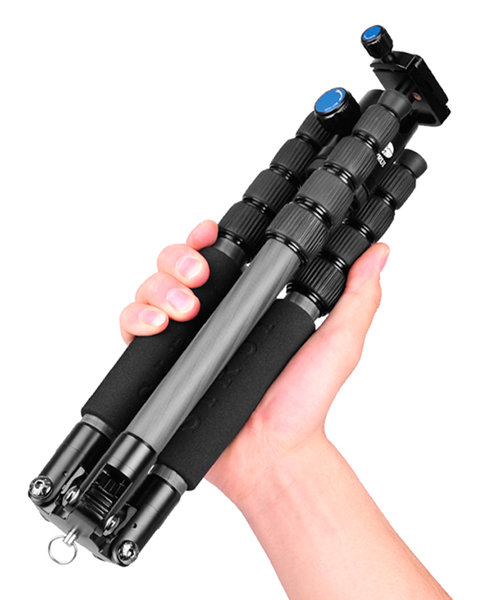
The Sirui T-025X tripod. (Source: Sirui Photographic Equipment.)
Sirui Photographic Equipment (Industrial) Co., Ltd., was founded in 2001 in Zhongshan City in South China. It is located within 90 km of five major cities: Guangzhou, Shenzhen, Zhuhai, Hong Kong and Macao. The company originally produced OEM products for another international company but launched its own Sirui brand in 2006, when it built a 20,000 square metre factory to handle increasing demands for products.
Sirui began making tripods and ball heads several years ago, building them to their own designs. According to its website, the company focuses upon 'high-end professional photographic & broadcast video equipment'.
The T-025X tripod we reviewed is the carbon fibre version of Sirui's T-005 tripod, which is made from aluminium and about 100 grams heavier - as well as AU$90 cheaper. It also comes in different colours (blue and red as well as basic black). Otherwise, both tripods have the same specifications.
Why Carbon Fibre?
Carbon fibre has several advantages over aluminium apart from lighter weight. Weight-for-weight it can support heavier loads and being a synthetic polymer, it is resistant to temperature changes. Your fingers won't fry if you pick it up after shooting in the hot summer sun nor will they freeze if you're working in sub-zero temperatures.
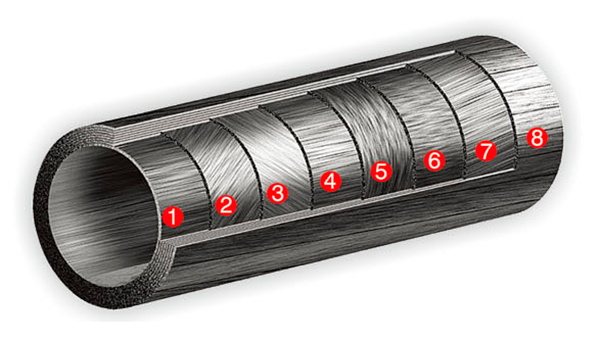
Eight layers of carbon fibre make up each leg section in the Sirui T-025X tripod. (Source: Sirui Photographic Equipment.)
Carbon fibre tripods are less susceptible to vibration than aluminium tripods. They also tend to be more durable. However, aluminium tripods are more tolerant of dust and sand and can withstand rougher handling. They will also bend under stress, whereas carbon fibre tripods will shatter. If you use your tripod in high humidity or wet conditions, aluminium can be susceptible to corrosion, whereas carbon fibre is not.
Who's it For?
Although they claim a load capacity of 6 kg, Sirui's T-0X series tripods are designed primarily for compact camera bodies and will suit fixed lens digicams, CSCs and small DSLRs. They can also be used with consumer-level video camcorders. Their relatively light weight and five-section legs make them less suitable for larger DSLRs (or CSCs with heavy telephoto lenses), although they can be used with larger cameras as long as the load is well-balanced and less than 6 kg and they are on a smooth and stable surface.
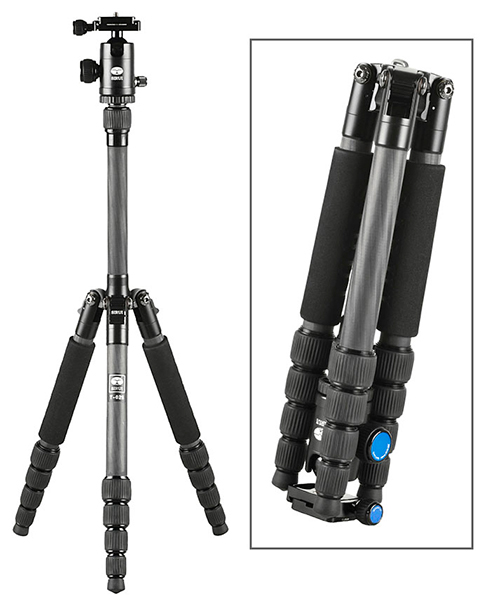
The Sirui T-025X tripod shown in both set up and folded configurations. (Source: Sirui Photographic Equipment.)
The T-025X is the lightest and most compact model that can extend to over one metre in height. It also folds up to be the smallest of any tripod with such capability, making it ideal for travellers.
Build and Operation
Each tripod comes in a dust-resistant bag with a rope shoulder strap and closure, which also contains a small zip-lock pouch containing two printed user manuals in English (one for the tripod and the other for the ball head), two Allen/Hex keys (the same size), a carabiner clip for a weight bag, a warranty card and a stamped inspection certificate.
Each leg has five sections that clamp together with twist clamps. Padded foam covers (described by Sirui as 'leg warmers') are attached to two of the top leg sections to provide a comfortable grip. The clamps at each leg joint are clad in thickly-ridged rubber that also provides a secure, non-slip point of contact and makes locking easy.
When packed, the tripod legs are turned up through 180 degrees to lie alongside the main column. As you pull them out from the column they pass through three distinct click stops where they can be locked securely into position.
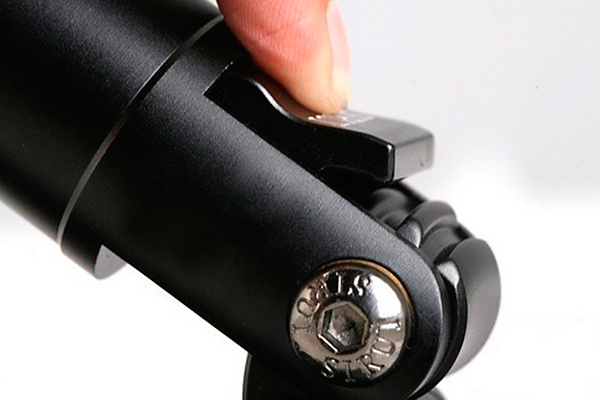
The leg locks for the Sirui T-025X tripod. (Source: Sirui Photographic Equipment.)
A spring-loaded latch passes over a set of grooves that align with those in identical locking mechanisms in all three legs to ensure the leg angles match. This latch has a contoured lip on its lower edge that is pressed to release the lock when you want to open the legs wider or fold them up. (You need to tilt the leg slightly down to release the latch.)
Once you've mastered it, this locking system is quick to use and the legs can be angled in three different positions: at roughly 105 degrees, 130 degrees and 190 degrees to the vertical. The fourth, 'unlocked' position has the legs folded up to surround the central column.
Each leg is set individually, making it possible to tilt the head by setting one leg to a different angle from the others. Setting all three legs to the 105-degree position provides a stable base for low-angle shooting with the camera about 40 cm above the ground (or surface) when the centre column is in position.
Leg lengths are set by twist clamps that must be tightened to hold the leg sections together. Ridged rubber covers make them easy to operate and they showed no signs of slippage, even when we fitted a large DSLR with medium telephoto lens attached. In some respects it's unfortunate to have the legs in five sections as this extends setting up times and can also reduce stability. But that's the price paid to have a tripod that packs down to 30 cm in length.
The tips of the legs have permanently-attached rubber pads, which are ideal for smooth surfaces but less suitable for outdoor usage. Sadly, you can't attach spikes or other kinds of modification to provide a stable grip on uneven ground.
The Ball Head
The C-10 ball head screws onto the mounting plate at the top of the central column. Made from solid anodised aluminium, it looks and feels strong. The 29 mm diameter ball is also made from anodised aluminium and is permanently attached to the head that holds the camera. It's relatively small, which means it doesn't move as smoothly as larger ball heads (which are typically 35-40 mm in diameter).
Three protruding adjustment knobs enable users to clamp different parts of the head. The lowest (and smallest) knob lets you adjust the rotation of the head. Unlock it and the head will swivel horizontally. Degrees of rotation are etched in 15-degree increments on the lower surface of the head (with two lines between adjacent numbers). They are revealed as the head is turned past a fixed notch when panning and shooting panoramas.
Further up and on the other side of the head is the main tension control knob, which clamps the ball mount in its socket. This knob is large with an indented and ridged grip that lets users tighten the clamp relatively easily. The socket has a scoop cut out of it that lets you tilt the camera into portrait orientation. It's quick and easy to use and you don't have to detach the camera. But there's no bubble level to ensure the camera is level when in landscape mode.
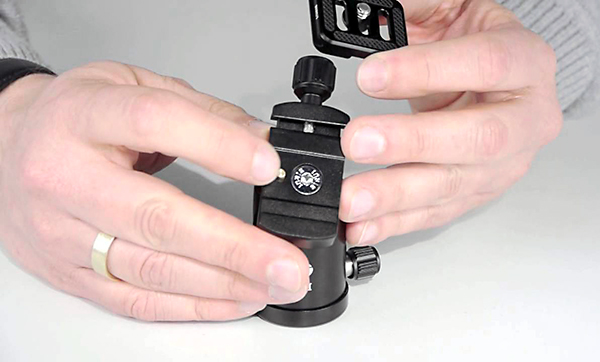
The quick-release camera plate, shown with the ball head. (Source: Sirui Photographic Equipment.)
The camera platform atop the ball is quite minimalistic. It's little more than a holder for a quick-release plate that has a surface area of only 36 x 28 mm. Attached to the surface of this plate are four thin rubber strips with cross-hatched ridges to hold the camera in place and provide a small amount of cushioning. The clamping knob that screws in to hold the plate is located on the side of the platform. It's midway in size between the other two knobs and similarly ridged.
The camera is attached to the plate with an aluminium screw that fits into a standard camera tripod socket. The top of the screw (which is on the underside of the plate) carries a slot that is wide enough to fit a coin (or one of the supplied Allen keys), allowing users to tighten it. We found it easy enough to turn this screw with a finger until it was tight enough to hold a Canon EOS 5D Mark II camera with 24-105mm lens easily without slippage or tilting when the tripod was on a flat, stable surface.
Panning with such a large and heavy camera and lens is easier when you release the lowest knob that allows the head to be rotated. If you try panning by releasing the ball, it is almost impossible to keep the camera level - even when smaller cameras are used.
Centre Column and Bag Hook
The centre column is in two sections, with the inner column pulling up 145 mm to raise the mounting plate for the ball head. A twist clamp similar to the ones used on the legs, locks the inner column in place.
If you want to increase the overall stability of the tripod and/or shoot from a lower vantage point, you can unscrew and remove the entire central column. But you must also take off the mounting plate and screw it onto the top of the legs. (It helps to put a little outward tension on the plate as you unscrew it.) Without the centre column, you can position your camera within 10 cm of the ground.
Re-attaching the column simply involves unscrewing the mounting plate and screwing it back onto the top of the column. You then screw the column back onto the top of the legs.
On the under surface of the centre of the tripod (where the tops of the legs meet) is a small metal loop that allows you to hang a weight to add stability to the tripod. The carabiner clip is provided for attaching this weight, which can be a sand bag, camera bag or other heavy item.
The carabiner isn't particularly large, although it's adequate for its purpose. It is partly clad with a soft plastic sheathe that helps to prevent suspended items from swinging in the wind and de-stabilising the tripod.
Conclusion
The Sirui T-025X tripod isn't the cheapest compact tripod on the market but it is definitely the cheapest carbon fibre one. It's also the lightest compact tripod we were able to find - and the combination of small size, light weight and affordable price tag makes it very attractive. But it's not without a few (albeit relatively minor ) flaws.
The following features (which are found in tripods from other manufacturers) would make this tripod a 'must have' for anyone looking for a lightweight, compact tripod:
1. It would be great to be able to unscrew one of the legs and attach it to the central column to produce a lightweight monopod.
2. The ability to add spiked feet would be useful for landscape photographers.
3. A bubble level would be handy.
Aside from these, the Sirui T-025X tripod is so easy to carry it's likely to qualify as the 'best' tripod since it's the one you are most likely to have at hand. Whether it's in your camera bag or attached to it, carried on your belt loop or sitting in a bicycle basket or on a car seat, it's a small burden to carry. And it comes with a six-year warranty for peace of mind.
SPECS
Material: Carbon Fibre legs; aluminium ball head
Load Capacity: 6 kg
Leg Sections: 5
Leg Tube Diameters: Max. 22 mm, Min.10 mm
Leg Lock Type: Twist
Independent Leg Spread: Yes
Spiked/Retractable Feet: No
Removable centre column: Yes
Centre Brace: No
Head Type: Ball head with Arca-style quick release plate
Maximum Height: 1391 mm
Minimum Height: 260 mm
Retracted Height: 480 mm
Folded Length: 300 mm
Weight: 800 grams including ball head
Link Source:http://www.photoreview.com.au/reviews/accessories/sirui-t-025x-carbon-fibre-tripod-kit